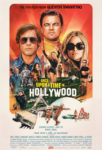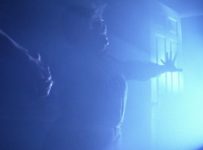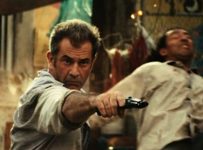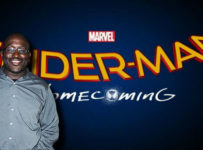So much has been made of this being Quentin Tarantino’s 9th film, partly because he has made a claim he will stop at 10. So before even stepping into the cinema, the publicity for ONCE UPON A TIME…IN HOLLYWOOD is asking you to consider this not just as a standalone film, but as a continuation of Tarantino’s oeuvre.
The 1960s Los Angeles setting seems like a perfect playground for a filmmaker who has built his career around pastiche. He can cut away to any retro tribute he likes, stage a miniature western inside the film, and have any number of beautiful hippies wandering around with dirty bare feet. The film opens with a ‘behind the scenes’ NBC commercial for the faux 1950s series Bounty Law, partly inspired by Wanted Dead or Alive, setting the tone for a series of similar riffs.
The story proper kicks off in 1969 as faded television star Rick Dalton (Leonardo DiCaprio) confides to his stunt double and best friend Cliff Booth (Brad Pitt) that he believes his career to be over. As Dalton prepares to play a villain in a new western pilot, Booth runs afoul of some local hippies. Meanwhile, Dalton’s neighbours Sharon Tate (Margot Robbie) and Roman Polanski (Rafał Zawierucha) continue to attend parties and listen to music.
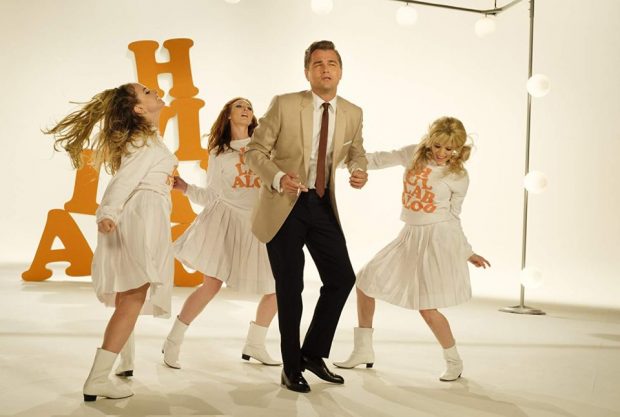
Tarantino adopts a familiar non-linearity by cutting back and forth between key moments in the player’s lives. A shirtless Pitt stands on the roof of Dalton’s Hollywood home, for example, recalling that time he fought Bruce Lee (Mike Moh), depicted here as a bit of a pompous windbag. This, and many moments like it, put aside any pretence Tarantino has previously had of “tribute” and straight up goes for fetishising the business of show. No opportunity is missed to recreate a vintage TV show or film, going so far as to insert DiCaprio into footage from The Great Escape. Tarantino doesn’t so much integrate these nods as continually reference them: even the title is a reference to his beloved Leone films.
Perhaps spying the end of his self-imposed filmography, Tarantino allows himself plenty of time to linger over long shots of driving up driveways, or what feels like entire episodes of television inserted into the middle of a scene. At its best, we get extended sequences of Pitt walking through a former western set while confronting a set of hippies, the staging and cinematography (from regular collaborator Robert Richardson) looking like the heightened language of Sergio Leone or John Ford.
Tarantino’s ear for dialogue is maintained in Dalton and Booth’s exchanges, a glorification of a misremembered era on “manly men”, or more accurately what Richard Brody called (in The New Yorker) a celebration of “white-male stardom…at the expense of everyone else.” There is some fragility to these characters, including an excellent scene where Dalton berates himself for flubbing his lines. Initially played for laughs, the scene turns darker due to its sheer length (which makes it a microcosm for the 161-minute film, really). Booth is also hinted to have a “weakness” of sorts, a past filled with old Hollywood murder and mystery. Yet by the time we get to the film’s explosive conclusion, his history of violence against women is celebrated (and maybe even justified) in a spectacular fashion.
Which is the most problematic aspect ONCE UPON A TIME…IN HOLLYWOOD. If film and pop culture is fetish, then the women are merely Tarantino’s props. The excellent Robbie goes through most of the film without dialogue. Introduced dancing in the background of a Pan Am flight, for most of her scenes she is a pair of boots or a miniskirt. There is a wonderful moment where she sits anonymously in a cinema, enjoying the audience reactions to Phil Carlson’s The Wrecking Crew, although this is also filtered through a ubiquitous set of bare feet resting on the seat-back in the foreground.
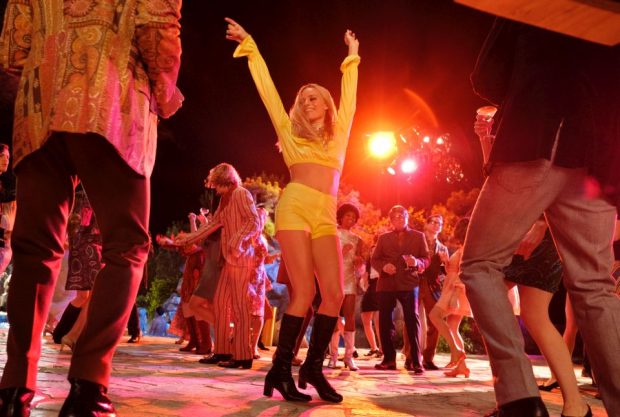
Of course, the film is not about Tate, which would partly explain her lack of agency. This doesn’t cover some of the broader issues with the film. Except for a fleeting appearance from Zoe Bell, every other woman is portrayed as an object. Case in point is Margaret Qualley as “Pussycat”, an amalgam of several members of the Manson Family. No opportunity is missed to linger on the back side of her Daisy Dukes or (naturally) her bare feet pressed against glass. While it’s not Tarantino’s job to create universal representation in every film, here it borders on being wilfully aggressive.
The less revealed about the ending the better, and indeed a pre-film card instructed us not to tell a soul of the film’s outcome. Suffice it to say that fans of Inglourious Basterds and The Hateful Eight will know that rugs can and will be pulled out from under us at any moment. Chaotically violent, indulgent, and often hilarious, the Cielo Drive finale will justifiably leave most audiences with a giddy breathlessness that almost erases the misgivings of the two-and-a-half-hours that preceded it.
ONCE UPON A TIME…IN HOLLYWOOD is ultimately a vehicle of self-reflection for Tarantino, one that treads (and frequently crosses) the thin line between tribute and self-parody. At times it feels as though someone else has made the film as a fanfic expansion of the Tarantino Cinematic Universe, complete with Red Apple cigarettes. Yet for the most part it is a fairy tale of a bygone and often troubling era of Hollywood, a kind of time machine that allows the filmmaker to insert himself into his own prehistory and heroically right its wrongs.
2019 | US | DIR: Quentin Tarantino | WRITER: Quentin Tarantino | CAST: Leonardo DiCaprio, Brad Pitt, Margot Robbie, Emile Hirsch, Margaret Qualley, Timothy Olyphant, Austin Butler, Dakota Fanning, Bruce Dern, Al Pacino | DISTRIBUTOR: Sony Pictures Releasing (AUS) | RUNNING TIME: 161 minutes | RELEASE DATE: 15 August 2019 (AUS)


